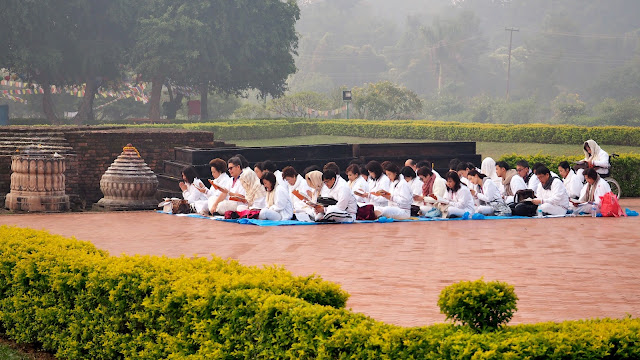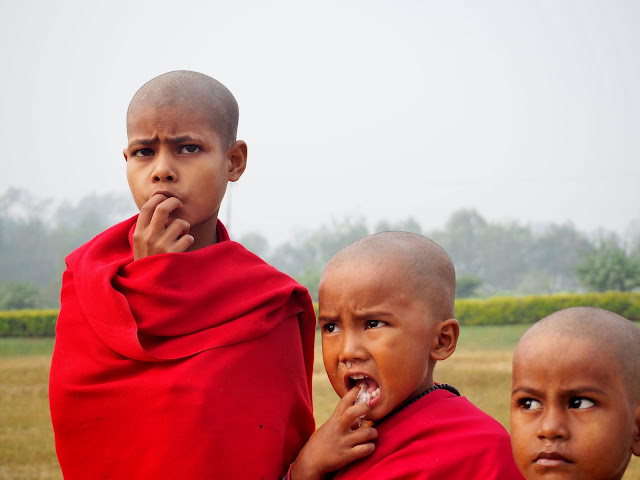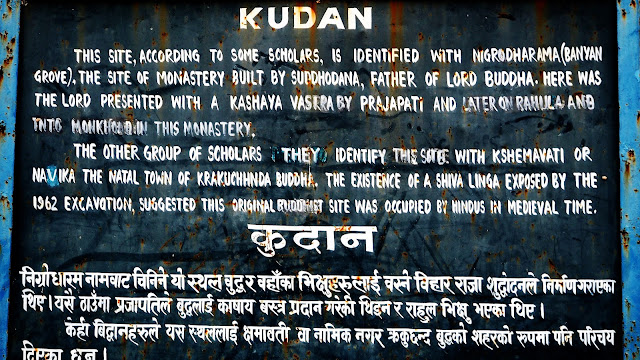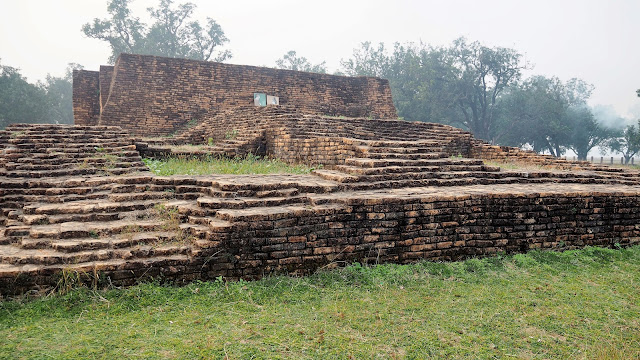“In the Master’s Footsteps” 24 Nov - 5 Dec 2014 (12D/11N)

Dr. Basanta Bidari (left) and Datuk Seri Dr. Victor Wee holding the 2 books published by Dr. Basanta Bidari
Day 8 (01.12.2014) Lumbini the birthplace of the Buddha.
The morning call was at 6am and breakfast at 7am. At 8am we all walked to Lumbini Garden to see the birth place of the Buddha in the ancient Shakya Kingdom. Tour of the Lumbini includes the Ashoka or Rummir Pillar, base relief image of Maya Devi Puskarini, the sacred pool sanctum – Santorum of the birthplace of the Buddha.
At 10.30am we walked to Panditarama Lumbini International Vipassana Meditation Center (Myanmar) to perform Dana to 8 monks. After that we offered food to the yogis in the center. There was a talk by the monk. We then visited The Great Drigung Kagyud Lotus Stupa. At 11.30am we took the bus back to hotel for our lunch at 11.45am.
In the afternoon at 1.45pm we depart for Kudan to visit the main temple with an Eastern Gate and a Western Gate. We then did a ten minutes meditation at the Eastern Gate. We came back to hotel for dinner at 7pm.
Breakfast / Lunch / Dinner and overnight at Hotel Buddha Maya in Lumbini.

Cheong Jin Jee and Ching Bee Geok taking breakfast at Hotel Buddha Maya in Lumbini.

At 8am we all walked about 25 minutes to Lumbini Garden from Hotel Buddha Maya.

We walked about 25 minutes to Lumbini Garden from Hotel Buddha Maya.

Y.S. Khong and Ching Neng Bin in front of the Lumbini Garden gate entrance.

Lumbini, in the Terai plains of Nepal is the birthplace of the Lord Buddha and is considered as one of the greatest pilgrimage sites for Buddhists. It had been declared a UNESCO heritage and the site is now being developed as a Buddhist pilgrimage centre, where the archaeological remains associated with the birth of the Lord Buddha.

Dr. Basanta Bidari the Chief Archaeologist shared his work with us at Lumbini Garden.

Nuns on rickshaw in Lumbini.

The gate entrance and security check to Lumbini Garden.

Maya Devi Temple is an ancient Buddhist temple situated at the UNESCO World Heritage Site of Lumbini, Nepal and very close to the Indo–Nepal border. It is considered the birthplace of Gautama Buddha. The temple stands adjacent to a sacred pool (known as Puskarni) and a sacred garden. The archaeological remains at the site were previously dated to the third-century BCE brick buildings constructed by Ashoka. A sixth-century BCE timber shrine was discovered in 2013.

Dr. Basanta Bidari the Chief Archaeologist shared his work with us at Lumbini Garden.

At Lumbini Garden.

Maya Devi Temple is an ancient Buddhist temple in Lumbini.

The Mayadevi Shrine is surrounded by several groups of stupas. So far, 31 stupas representing 3 different categories have been excavated at the Sacred Garden of Lumbini. Of them, 29 are Votive Stupas, 1 Relic Stupa and 1 Dhamma Stupa. The large number of ancient stupas in the vicinity signifies the importance of Lumbini as one of the holiest sites of pilgrimage after the Mahaparinirvana of Lord Sakyamuni Buddha.
The stupas were constructed here from 3rd century BC until 8th or 9th century AD through the Mauryan, Sunga, Kushana and Gupta periods. Stupas erected at Lumbini Sacred Garden are of different types, designs and styles, primarily having square, rectangular and circular bases.

The Lord Buddha was born in 623 BC in the sacred area of Lumbini located in the Terai plains of southern Nepal, testified by the inscription on the pillar erected by the Mauryan Emperor Asoka in 249 BC. Lumbini is one of the holiest places of one of the world's great religions, and its remains contain important evidence about the nature of Buddhist pilgrimage centres from as early as the 3rd century BC.

The Lumbini complex of structures within the archaeological conservation area includes the Shakya Tank; the remains within the Maya Devi Temple consisting of brick structures in a cross-wall system dating from the 3rd century BC to the present century and the sandstone Ashoka pillar with its Pali inscription in Brahmi script.

Dr. Basanta Bidari the Chief Archaeologist shared his work with us at Lumbini Garden.

BGF group member beside Maya Devi Temple, Lumbini Garden.

It is pointed out by scholars that the temple of Maya Devi was constructed over the foundations of more than one earlier temple or stupa, and that this temple was probably built on an Ashokan stupa itself. To the south of the Maya Devi temple there is the famous sacred bathing pool known as Puskarni. It is believed that Maya Devi took a bath in this pool before the delivery. By the side of the Ashoka pillar a river which flows south-east and is locally called the Ol. In 1996, an archaeological dig unearthed a 'flawless stone' placed there by Ashoka in 249 BC to mark the precise location of the Buddha's birth more than 2,600 years ago. If authenticated, the find will put Lumbini even more prominently on the map for millions of religious pilgrims.

Meditation by BGF group beside Maya Devi Temple, Lumbini Garden.

Vipassana meditation from the Theravada tradition is a practice of training the mind in continuous moment-to-moment mindfulness throughout the whole day. Through an unbroken and continuous observation of distinct physical and mental objects arising in one's meditation, a meditator will come to understand the three universal characteristics of all phenomena; that they are impermanent, unsatisfactory and void of an abiding self.

The mind has a tendency to be dominated by various unwholesome mental states such states as greed, anger, fear, ignorance, pride, wrong views, doubts, laziness, restlessness and worry, to name just a few. These may be seen as the causes for suffering, both in us and in all beings. But through careful observation these unwholesome mental states will subside, allowing wholesome mental states to arise in their place. Mental states such as effort, mindfulness, concentration, intuitive wisdom, joy, tranquility or peace, happiness, loving kindness, compassion, sympathetic joy, equanimity, contentment, and patience reduce suffering and increase a person's mental and physical well-being. This is known as the purification of the mind, which is another major benefit of Vipassana meditation.

Meditation by BGF group beside Maya Devi Temple, Lumbini Garden.

Buddhist chanting by other group beside Maya Devi Temple, Lumbini Garden.

Bodhi tree and the famous sacred bathing pool known as Puskarni beside Maya Devi Temple, Lumbini.

Buddhist Monks sitting around the Bodhi tree beside the pond at Lumbini Garden.

Children and monks around the Bodhi tree beside the pond at Lumbini Garden.

Monks around the Bodhi tree beside the pond at Lumbini Garden.

Children and monks around the Bodhi tree beside the pond at Lumbini Garden.

Children around the Bodhi tree beside the pond at Lumbini Garden.

A tourist taking picture with the children at Lumbini Garden.

Robert Chong and May taking picture with the children at Lumbini Garden.

Robert Chong taking picture with the children at Lumbini Garden.

At 10.30am we walked to Panditarama Lumbini International Vipassana Meditation Center (Myanmar) to perform Dana to 8 monks. After that we offered food to the yogis in the center.

Panditarama Lumbini International Vipassana Meditation Center (Myanmar).

Panditarama Lumbini International Vipassana Meditation Center was set up by Sayadaw U Panditabhivamsa of Myanmar in cooperation with the Venerable Sayadaw U Asabhacara and inaugurated on February 7, 1999.

Panditarama Lumbini offers a supportive, comfortable and peaceful setting for dhamma-students seeking practice. The meditation method is intensive Vipassana in the tradition of the Venerable Mahasi Sayadaw of Myanmar, which consists of sitting meditation and formal walking meditation throughout the day. Almost daily interviews and regular Dhamma-talks in English. Meditators observe Noble Silence and keep eight precepts.

Performing Dana to 8 monks at Panditarama Lumbini International Vipassana Meditation Center.

Performing Dana to 8 monks at Panditarama Lumbini International Vipassana Meditation Center.

Performing Dana to 8 monks at Panditarama Lumbini International Vipassana Meditation Center.

Performing Dana to 8 monks at Panditarama Lumbini International Vipassana Meditation Center.

Performing Dana to 8 monks at Panditarama Lumbini International Vipassana Meditation Center.

Performing Dana to 8 monks at Panditarama Lumbini International Vipassana Meditation Center.

Performing Dana to 8 monks at Panditarama Lumbini International Vipassana Meditation Center.

Performing Dana to 8 monks at Panditarama Lumbini International Vipassana Meditation Center.

Performing Dana to 8 monks at Panditarama Lumbini International Vipassana Meditation Center.

Performing Dana to 8 monks at Panditarama Lumbini International Vipassana Meditation Center.


Eternal Peace Flame Monument in Lumbini Sanskritik, Nepal.

The canal view from Eternal Peace Flame Monument in Lumbini.

The East Monastic Zone consists of monasteries that represent the Theravada (Hinayana) school of Buddhism. They are built and operated by different countries and, for the many pilgrims who visit Lumbini, they offer respite and spiritual programs in keeping with local traditions.

Y.S. Kong, Mike Khaw and Ching Neng Bin beside the lake at Great Drigung Lotus Stupa Lumbini.

Great Drigung Lotus Stupa is one of the most religiously important Stupas in Lumbini and was built by the German Tara Foundation. The building contains a hollow crown partly covered in glass which reveals the Buddha statue inside. The historical significance of this building goes back centuries when the construction of this building was under the supervision and guidance of the Rinpoches. This Stupa is definitely worth a visit when in Lumbini.

The Great Drigung Kagyud Lotus Stupa in Lumbini.

The Great Drigung Kagyud Lotus Stupa in Lumbini. The domed ceiling of the Stupa is covered with Buddhist murals. The gold, wood and carvings represent the beliefs and teachings of Buddha that spreads the message of peace and non-violence. Each year, this Supa sees a great number of congregations at Great Dridung Lotus Stupa where the Highness himself visits the place to spread the message of unity and peace.

The Great Drigung Kagyud Lotus Stupa in Lumbini.

The Great Drigung Kagyud Lotus Stupa in Lumbini.

The Great Drigung Kagyud Lotus Stupa in Lumbini.

The Great Drigung Kagyud Lotus Stupa in Lumbini. The birth of Siddhartha in Lumbini.

The Great Drigung Kagyud Lotus Stupa in Lumbini.

The Great Drigung Kagyud Lotus Stupa in Lumbini.

The Great Drigung Kagyud Lotus Stupa in Lumbini.

The Great Drigung Kagyud Lotus Stupa in Lumbini. Siddhartha cutting hair.

The Great Drigung Kagyud Lotus Stupa in Lumbini. Six years of self-mortification.

The Great Drigung Kagyud Lotus Stupa in Lumbini. Mara's temptations.

The Great Drigung Kagyud Lotus Stupa in Lumbini. The Enlightenment.

The Great Drigung Kagyud Lotus Stupa in Lumbini.

The Great Drigung Kagyud Lotus Stupa in Lumbini. The Mahaparinirvana.

The Great Drigung Kagyud Lotus Stupa in Lumbini.

Kudan is where King Suddhodhan met Lord Buddha for the first time after returning from his enlightenment.

Dr. Basanta Bidari the Chief Archaeologist shared his knowledge about Kudan near Lumbini.

The Rahula Stupa has an octagonal Shiva temple on top of it that was built much later by Hindus. A series of stupas at Kudan honour moments of Buddha’s life that happened here, including the meeting with his father, King Suddhodhana, seven years after his enlightenment.


Kudan located some 4.5 km south of Tilaurakot, is where King Suddhodhan met Lord Buddha for the first time after returning from his enlightenment. It was here that the Kasaya (yellow robe worn by monks) was presented to Lord Buddha. It was also here that the Kasaya was presented by Lord Buddha to Rahul, his son.

Kudan became a key location in the spread of Buddha’s message as family members welcomed his mission, including his son Rahula, who was ordained here at the age of 8.

Kudan is where King Suddhodhan met Lord Buddha for the first time after returning from his enlightenment.

The Buddha preached five important sutras and told the story of his search for supreme knowledge here during his stay with 300 his disciples at Kudan.

Kudan is where King Suddhodhan met Lord Buddha for the first time after returning from his enlightenment.

Ancient Kapilavastu is the name of the ancient city where Siddhartha Gautama the Buddha, was raised and lived until the age of 29, when he renounced worldly life.

Western Gate of Kapilavastu, the ancient Shakya city where Siddhartha Gautama lived until the age of 29.


Ancient Kapilavastu four gates have been found along the fortification wall in each cardinal direction. Of the four gates, archaeologists have so far excavated two. The exposed western gate is made up of bricks, brickbats, mortar, wood and iron, had many doors, one after another.

Archaeologist T. N. Mishra found three phases of construction of the Ancient Kapilavastu gateway. He found the first and second phases of construction in the layer 3 dating from 2nd-1st century B.C. The third phase of construction is associated with layer 2, which dates from 1st – 2nd century A.D (Bidari, 2007: 259).

Ancient Kapilavastu the capital of Sakya Kingdom.

Eastern Gate of Kapilavastu, the ancient Shakya city where Siddhartha Gautama lived until the age of 29. The Eastern Gate was the gate through which he is supposed to have left the city on his quest to attain the end of suffering.

P. C. Mukherji explored the eastern gate in 1899. He uncovered an ancient large square building close to the gate, which he assumes that might have been used for security purposes. The middle section of the eastern fort wall, which has been identified as the Mahaviniskramana Dwara or Mangal Dwara, is the gate from where Prince Siddhartha walked out of the palace (Rijal, 1996). It is said that when Prince Siddhartha set out on the journey, the guards posted at the gate and people of Kapilavastu had fallen asleep and did not notice anything (Mitra, 1998). A number of doors found along the gateway are guardrooms that indicates a high degree of precaution and security management of the palace, the main administrative complex and the residences of the king.

Dr. Basanta Bidari shared his knowledge about Ancient Kapilavastu the capital of Sakya Kingdom.

Back in Hotel Buddha Maya in Lumbini for dinner. We also bought books from Dr. Basanta Bidari.
Pilgrimage Itinerary:
Day 01 (24.11.2014) Kuala Lumpur to Bangkok to Bodhgaya, India
Day 02 (25.11.2014) Bodhgaya to Dungeswari Cave - Sujata Stupa - Bodhgaya
Day 03 (26.11.2014) Bodhgaya to Rajgir by coach (80km, 3 hrs drive)
Day 04 (27.11.2014) Rajgir to Gijjhakuta Hill (Vulture Peak) - Nalanda - Rajgir
Day 05 (28.11.2014) Rajgir to Vaishali by coach (130km, 5 hrs drive)
Day 06 (29.11.2014) Vaishali to Kushinagar by coach (180km, 6hrs drive)
Day 07 (30.11.2014) Kushinagar to Lumbini by coach (160km, 7hrs drive)
Day 08 (01.12.2014) Lumbini in, Nepal
Day 09 (02.12.2014) Lumbini to Sravasti by coach (250Km, 8hrs drive)
Day 10 (03.12.2014) Sravasti to Varanasi by coach (270Km, 11 hrs. drive)
Day 11 (04.12.2014) Varanasi to Sarnath. Varanasi to Bangkok TG328 16:30hrs 21:15hrs
Day 12 (05.12.2014) Bangkok to Kuala Lumpur
///
Day 01 (24.11.2014) Kuala Lumpur to Bangkok to Bodhgaya, India
Day 02 (25.11.2014) Bodhgaya to Dungeswari Cave - Sujata Stupa - Bodhgaya
Day 03 (26.11.2014) Bodhgaya to Rajgir by coach (80km, 3 hrs drive)
Day 04 (27.11.2014) Rajgir to Gijjhakuta Hill (Vulture Peak) - Nalanda - Rajgir
Day 05 (28.11.2014) Rajgir to Vaishali by coach (130km, 5 hrs drive)
Day 06 (29.11.2014) Vaishali to Kushinagar by coach (180km, 6hrs drive)
Day 07 (30.11.2014) Kushinagar to Lumbini by coach (160km, 7hrs drive)
Day 08 (01.12.2014) Lumbini in, Nepal
Day 09 (02.12.2014) Lumbini to Sravasti by coach (250Km, 8hrs drive)
Day 10 (03.12.2014) Sravasti to Varanasi by coach (270Km, 11 hrs. drive)
Day 11 (04.12.2014) Varanasi to Sarnath. Varanasi to Bangkok TG328 16:30hrs 21:15hrs
Day 12 (05.12.2014) Bangkok to Kuala Lumpur
///